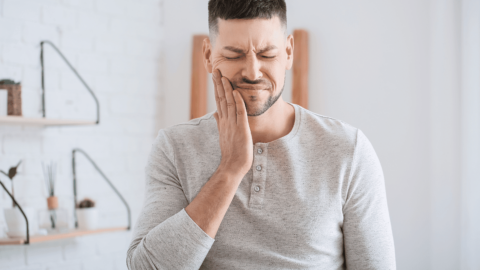The most common cause of toothache or tooth pain is an infected tooth. The pulp is found in the inner portion of a tooth, protected by the hard, bony outer layers (enamel). The pulp contains soft connective tissue, blood vessels, and nerves. When cavities or a broken tooth damage the enamel, bacteria can enter the pulp. This can lead to heat, cold, or pressure, causing intense pain.
Once the pulp gets infected, the pain can become constant and can even spread to the whole side of the face or cause headaches.
Early Infections
When a toothache first strikes, a nonsteroidal anti-inflammatory drug (NSAID) such as Aspirin, Tylenol, or ibuprofen can ease the discomfort. Holding an ice cube wrapped in a washcloth up to your cheek for about 15 minutes per hour can help, too.
Then, it is time to see a dentist to solve the underlying problem—sometimes a root canal or pulling the diseased tooth. Antibiotics may sometimes be helpful to treat an early infection and prevent it from becoming more serious; however, they do not treat the underlying problem.
More Severe Infections
Pulpitis
This condition forms when the pulp becomes inflamed because of bacterial infection and swells, putting pressure on the nerve.
Signs and symptoms:
- Swollen lymph nodes
- Painful rash
- Fever
- Chills
- Difficulty swallowing
- Difficulty opening mouth
Treatment
It may involve antibiotics (as a temporizing measure), getting a filling, removing the tooth, or possibly removing the pulp (root canal).
Periapical Abscess
This occurs when an infection forms at the root of the tooth.
Signs and symptoms:
- Severe pain throbbing can radiate to the jaw, neck, ear
- Sensitive to hot and cold
- Sensitive to the pressure of chewing or biting
- Fever
- Swelling in cheek
- Swollen, tender masses under the jaw or in the neck
- Sudden pain relief if the abscess bursts, releasing foul, salty fluid throughout the mouth
- Difficulty swallowing or breathing
Treatment
It usually consists of antibiotics, removing the tooth or performing a root canal, and, in some cases, incising and draining the infection.
Antibiotics for Tooth Infections
- Amoxicillin: A type of penicillin may be given with clavulanic acid, 500 to 2,000 mg every 8 to 12 hours.
- Amoxicillin with clavulanate: Another antibiotic may be taken in a dosage of 875 mg/125 mg twice a day.
- Clindamycin: This antibiotic can treat more types of bacteria and may be prescribed in a dose of 300 or 600 mg every 8 hours.
- Azithromycin: Given to patients allergic to penicillin in a dose of 500 mg every 24 hours for three days.
- Clindamycin: In a dose of 150 mg, it may be taken four times a day.
Taking probiotics while taking antibiotics for dental infections is a good idea. Probiotics help avoid antibiotic-associated diarrhea.
Did you know? QuickMD can help you diagnose the cause of your dental pain via telemedicine and prescribe antibiotics online if needed.




